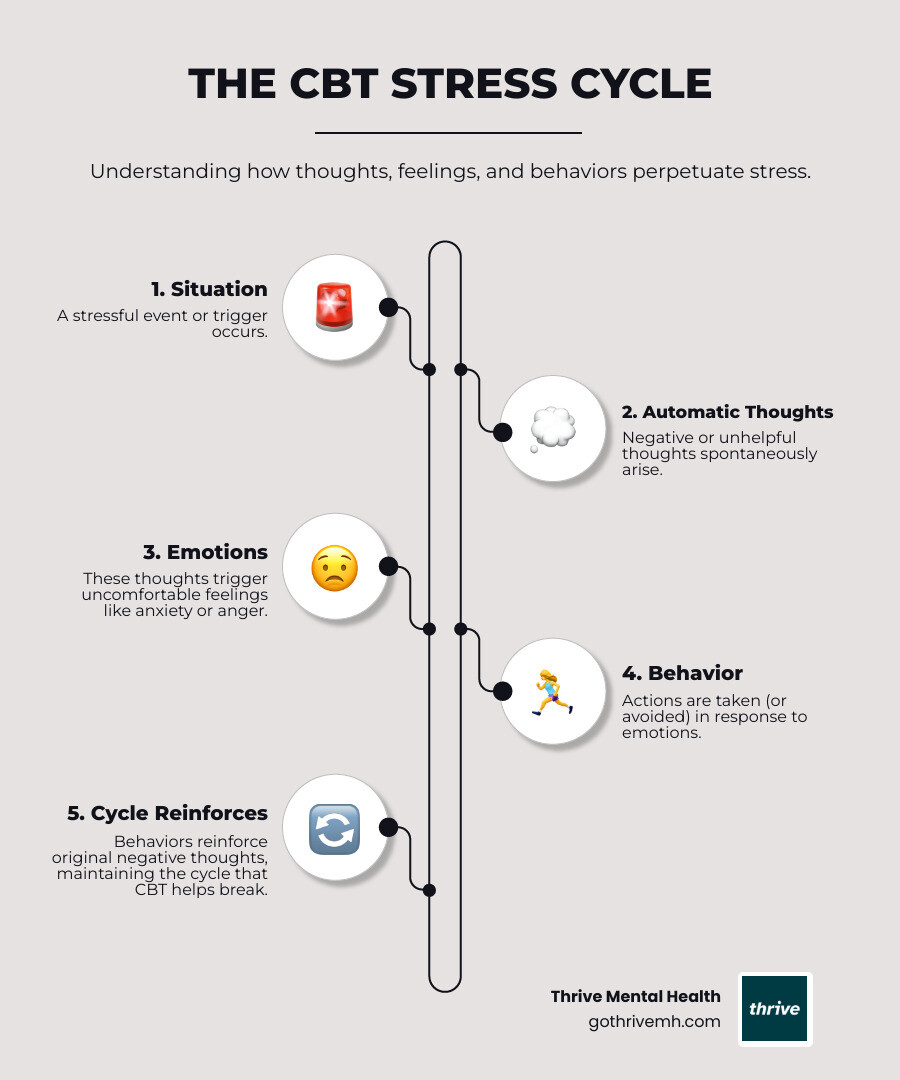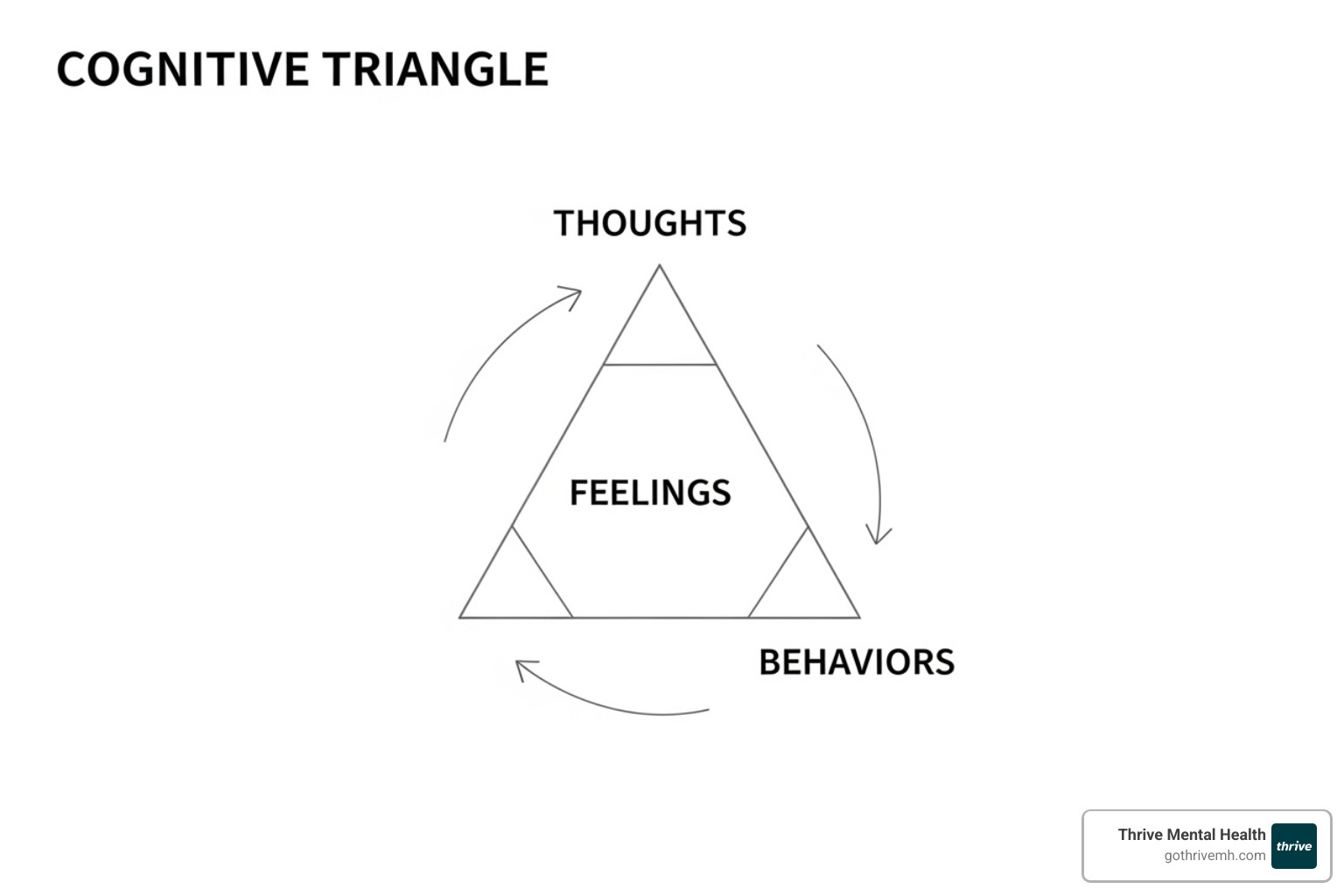Feeling Stressed? CBT Techniques to the Rescue!

Why CBT for Stress Management Is Your Best First Step
CBT for stress management is a proven, science-backed approach that helps you change the negative thought patterns that fuel stress. Unlike other therapies that dig into your past, CBT focuses on practical skills you can use right now to break the cycle of stress and anxiety.
Quick CBT Stress Management Techniques:
- Cognitive Restructuring – Question and reframe negative thoughts
- Behavioral Activation – Schedule pleasant activities to boost mood
- Problem-Solving Skills – Break overwhelming situations into manageable steps
- Relaxation Techniques – Use deep breathing and muscle relaxation
- Thought Records – Track triggers and responses to identify patterns
Stress affects 73% of people’s mental health and 77% experience physical symptoms from chronic stress, according to the American Psychological Association. The good news? CBT helps you eliminate the avoidant behaviors and faulty beliefs that keep stress spiraling out of control.
CBT works by targeting the connection between your thoughts, feelings, and behaviors. When you’re stuck in traffic, for example, one person might think “This is ruining my whole day” while another thinks “Perfect time to listen to music and relax.” Same situation, completely different stress levels.
The beauty of CBT lies in its here-and-now focus. You don’t need months of therapy to see results – most people notice improvements within 5-20 sessions. Research shows CBT significantly reduces anxiety and depression symptoms, with effects that last long after treatment ends.
I’m Nate Raine, CEO of Thrive Mental Health, where I’ve seen how CBT for stress management transforms lives by giving people practical tools they can use anywhere, anytime. My experience leading behavioral health innovation has shown me that the most effective treatments are those that empower people with skills they can actually use in their daily lives.

Easy CBT for stress management word list:
The Core of CBT: How Changing Your Mindset Can Change Your Life
Here’s something fascinating: CBT for stress management works on a surprisingly simple principle. Your thoughts, feelings, and behaviors are all connected like pieces of a puzzle. When you change one piece, the others naturally shift too.
Think of it as the cognitive triangle. At the top, you have your thoughts. On the bottom left, your feelings. On the bottom right, your behaviors. They’re constantly influencing each other in an endless loop. When you’re stressed, this loop can become a downward spiral pretty quickly.
But here’s the good news – you can learn to interrupt that spiral and create a healthier pattern instead.

CBT for stress management is what we call a collaborative approach. You’re not lying on a couch while someone analyzes your childhood (though that has its place). Instead, you’re working actively with your therapist like a team. You’re learning practical skills you can use right now, today.
This skill-based therapy focuses on the here and now. Instead of spending months exploring why you developed certain patterns, you’re learning how to change them. It’s like learning to drive – you need to understand the basics, but mostly you need to practice until it becomes second nature.
The science backs this up too. Research shows that CBT for stress management helps people identify and change unhelpful thinking styles and cognitive distortions – those sneaky thought patterns that make everything seem worse than it actually is. You can dive deeper into the science of cognitive therapy or explore the basics of Cognitive Behavioral Therapy (CBT) to understand how this all works.
Identifying Your Stress Triggers and Patterns
Before you can manage stress, you need to become a detective of your own mind. The first step is catching those automatic negative thoughts – we call them ANTs for short. These little thoughts scurry through your brain so fast you barely notice them, but they pack a powerful punch.
Journaling and thought records are your best tools here. Don’t worry – you don’t need to write a novel. Just jot down what you notice when stress hits.
Pay attention to your situational triggers. Maybe it’s your boss’s tone in emails, or running late, or even certain times of day. Notice the physical sensations too – does your chest tighten? Do your shoulders creep up toward your ears? Does your breathing get shallow?
Track your emotional responses. Are you feeling anxious, frustrated, overwhelmed, or something else entirely? And finally, observe your behavioral reactions. Do you avoid certain tasks? Snap at people? Reach for your phone to scroll mindlessly?
When you start connecting these dots, patterns emerge. You might find that Sunday evenings trigger anxiety about the week ahead, or that hunger makes every small problem feel enormous. This awareness is the foundation of effective CBT for stress management.
The Connection Between Thoughts, Feelings, and Actions
Here’s where things get really interesting. Your stress isn’t actually caused by what happens to you – it’s caused by how you interpret what happens to you.
Let me paint you a picture. Two people are stuck in the same traffic jam. Person A thinks, “This is a disaster! I’m going to be late, everyone will think I’m unreliable, and my whole day is ruined!” They’re gripping the steering wheel, heart racing, getting more frustrated by the minute.
Person B thinks, “Well, this is annoying, but there’s nothing I can do about it. Good thing I have that podcast I’ve been wanting to listen to.” They’re relaxed, maybe even enjoying the unexpected break.
Same traffic jam. Completely different experiences. That’s the power of faulty thinking patterns and how your interpretation affects your reality.
CBT for stress management helps you recognize these patterns and break the cycle. You learn that emotional reasoning – assuming that because you feel something strongly, it must be true – often leads you astray. You find that many of your stress responses are actually learned behaviors that you can unlearn.
The beautiful thing is that once you understand this connection, you have options. You can’t always control what happens to you, but you can learn to control how you respond. And that makes all the difference in managing stress effectively.
Practical CBT for Stress Management: Techniques You Can Use Today
The real magic of CBT for stress management happens when you start putting these concepts into practice. Unlike other approaches that focus mainly on understanding why you feel stressed, CBT is all about doing something about it. You’ll learn concrete skills that you can use whether you’re stuck in traffic, facing a deadline, or dealing with difficult people.
Think of it as building a mental toolkit. Just like learning to ride a bike, these techniques become second nature with practice. That’s why CBT often includes homework assignments – not the kind that feels like punishment, but practical exercises that help you strengthen your new coping skills between sessions.
Self-monitoring remains your foundation throughout this process. By tracking your thoughts, feelings, and behaviors, you’ll start to see patterns and notice which techniques work best for your unique situation.

Technique 1: Cognitive Restructuring to Reframe Stressful Thoughts
Cognitive restructuring is like becoming a detective of your own mind. We all have those moments when our thoughts spiral into worst-case scenarios. Maybe you think, “I’m definitely going to mess up this presentation and everyone will think I’m incompetent.” Sound familiar?
This technique helps you catch these cognitive distortions – those sneaky thinking traps that make situations seem worse than they actually are. Common ones include all-or-nothing thinking (everything is either perfect or terrible), catastrophizing (assuming the worst will happen), and overgeneralization (one bad experience means everything will go wrong).
The key is learning to question these thoughts using what’s called Socratic questioning. Instead of accepting that panicked thought about your presentation, you might ask yourself: “What evidence do I have that this will actually happen? Have I given successful presentations before? What would I tell a friend having this same worry?”
Examining the evidence becomes your new superpower. You’ll start finding alternative explanations for situations that once seemed hopeless. Maybe that presentation anxiety isn’t proof you’ll fail – maybe it’s just your brain trying to help you prepare.
Thought records make this process even more effective. Write down the situation, your automatic thought, how it made you feel, and then work through those detective questions to find a more balanced perspective. With practice, this becomes almost automatic.
This process truly can transform how you experience stress. To dive deeper into this life-changing approach, check out How CBT Can Transform Negative Thought Patterns.
Technique 2: Behavioral Strategies for Immediate Stress Relief
Sometimes you need relief right now, and that’s where behavioral strategies shine. These techniques work by changing what you do, which then changes how you feel.
Behavioral activation is particularly powerful when stress has you withdrawing from life. When we’re overwhelmed, we often stop doing things we enjoy, which only makes us feel worse. This technique encourages you to schedule pleasant activities, even when you don’t feel like it. Your brain needs those positive experiences to break the stress cycle.
Here are some simple, pleasant activities that can provide immediate stress relief:
- Take a short walk outside and notice what you see
- Listen to your favorite music or find something new
- Call someone who makes you laugh
- Do some gentle stretching or yoga
- Spend time with a pet
- Cook or bake something you enjoy
- Read a few pages of a good book
- Take a warm bath or shower
Problem-solving skills help when stress comes from feeling overwhelmed by challenges. Instead of letting problems pile up in your mind, you learn to break them down systematically. Identify the specific issue, brainstorm possible solutions, weigh the pros and cons, pick the best option, and take one small step forward.
Time management techniques address one of the biggest stress triggers – feeling out of control with your schedule. You’ll learn to prioritize based on what’s truly urgent versus what just feels urgent, set realistic deadlines, and tackle tasks in a way that prevents that last-minute panic.
Assertiveness training teaches you to communicate your needs clearly and set healthy boundaries. Instead of saying “You always stress me out,” you might say “I feel overwhelmed when deadlines change suddenly. Can we discuss how to handle this better?” This reduces conflict and helps you feel more in control of your relationships.
Technique 3: Building Long-Term Resilience
While quick relief techniques are essential, CBT for stress management also focuses on building your long-term resilience – your ability to bounce back from whatever life throws at you.
Progressive Muscle Relaxation helps you become aware of tension you might not even notice you’re carrying. You systematically tense and then relax different muscle groups, teaching your body the difference between stress and relaxation. With practice, you can release tension almost instantly.
Calm breathing exercises work because they directly counteract your body’s stress response. When you’re stressed, your breathing becomes shallow and rapid. Techniques like diaphragmatic breathing (breathing deeply into your belly) or the 4-7-8 method (inhale for 4, hold for 7, exhale for 8) signal your nervous system that it’s safe to relax.
Mindfulness practices teach you to observe your thoughts and feelings without getting swept away by them. You might do a quick body scan, noticing any tension or discomfort without trying to fix it, or practice mindful eating by really focusing on the taste and texture of your food.
Developing self-compassion might be the most important resilience skill of all. We often add to our stress by being harsh critics of ourselves. Learning to treat yourself with the same kindness you’d show a good friend can dramatically reduce the internal pressure that fuels stress.
These techniques become more powerful the more you practice them. They’re not just stress-busters – they’re life skills that help you steer challenges with greater ease and confidence.
For more comprehensive strategies to build your resilience, explore Building Resilience Online: Coping Strategies for Long-Term Mental Health.
Does CBT Really Work for Stress? A Look at the Evidence
When you’re dealing with stress, you want solutions that truly work, right? The good news is that the effectiveness of CBT for stress management isn’t just a hopeful idea – it’s strongly supported by a mountain of scientific research. In fact, Cognitive Behavioral Therapy is recognized as one of the most reliable and widely proven methods available today.
CBT is considered a “first-line” treatment, meaning it’s often the first approach doctors and therapists recommend. It’s been clinically proven to significantly improve a range of issues, including anxiety, low mood, general stress, and even sleep problems. This isn’t just about feeling better in the short term; it’s about giving you concrete tools to manage stress by actively changing those unhelpful thought patterns.
One of the most appealing aspects of CBT is its efficiency. While everyone’s journey is unique, many people start to see real improvements after just a few sessions. Typically, a course of CBT for stress management might involve anywhere from 5 to 20 sessions. This focused, structured approach makes it a highly effective and time-conscious therapy.
CBT’s benefits aren’t limited to just stress. It’s also been shown to be effective for various mental health challenges like anxiety disorders, depression, and even certain eating disorders. It can even help with physical conditions that are often made worse by stress, such as chronic fatigue or irritable bowel syndrome.
Recent studies continue to highlight its power. For instance, a 2022 meta-analysis found that when people engaged in online CBT, they reported significant reductions in their stress, anxiety, and depression symptoms. What’s more, these improvements lasted over time! Another study focusing on university students showed that group training in CBT for stress management led to a notable drop in anxiety and boosted their psychological resilience and self-belief.

For a deeper dive into the extensive evidence supporting CBT’s effectiveness, you can explore this detailed review of meta-analyses: The efficacy of cognitive behavioral therapy: a review of meta-analyses.
So, what makes CBT for stress management such a powerhouse? It’s evidence-based, meaning it’s built on solid scientific research, ensuring you’re using a reliable and effective approach. It’s also wonderfully goal-oriented and structured, providing a clear path forward with specific goals and actionable steps. This helps your journey to stress management feel manageable and progressive.
CBT is a truly skill-based therapy. It doesn’t just talk about problems; it teaches you practical, lifelong coping skills. You learn how to identify and challenge negative thoughts, regulate your emotions, and adopt healthier behaviors. This empowers you to become your own therapist, equipped with tools you can use anytime, anywhere. Because it has a strong here-and-now focus, CBT addresses your current stressors directly, offering immediate relief and helping you handle real-time situations more effectively.
And the best part? CBT offers lasting results. Unlike quick fixes, the skills you learn promote long-term resilience and help prevent stress from spiraling out of control again. This means sustained well-being even long after your therapy concludes. Plus, it offers flexible delivery options, including individual or group sessions, and online platforms, making it accessible and adaptable to your life. Finally, CBT uses a collaborative approach, meaning you and your therapist work together as a team, ensuring a personalized and truly empowering treatment experience.